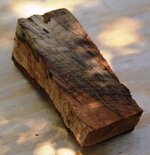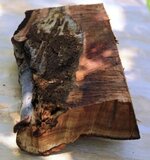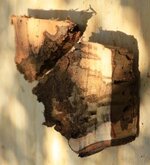rblakemore
Member
Looks like an expensive hobby is getting more expensive; and, I am now getting in over my head. These pieces are fresh maple from a neighbors tree, some of it is heavily spalted and may be too rotten. I need some help and advice please; refer to my post on cutting green wood in "Other Things We Make"; most pieces saved for large items; but, these are put aside for smaller items like pens. So, look at the pictures and help please.
9T4A7280_IAP: this is a center slab with lots of spalting and the center is rotten. Can I cut a strip out of the center and cast in alumilite as "worthless wood" and stabilize the rest and cut blanks from that piece???
9T4A7282_IAP: This is a nice piece closer to the outside bark; should I cut this up and stabilize each piece or stabilize the entire piece; this piece does not have large void, that means that casting as worthless is not the best option for this piece??
9T4A7283_IAP: This piece has some natural grain, spalting, and rotten sections with grub holes. Should I cut up and stabilize where I can and then make a mold and cast the section that is rotten and filled with grub holes.
9T4A7285_IAP: This piece has some natural grain, spalting, and more rotten section, in fact it broke. Can I cast this as a large piece with alumilite and make worthless wood?? Should I cut off part and stabilize first?
9T4A7280_IAP: this is a center slab with lots of spalting and the center is rotten. Can I cut a strip out of the center and cast in alumilite as "worthless wood" and stabilize the rest and cut blanks from that piece???
9T4A7282_IAP: This is a nice piece closer to the outside bark; should I cut this up and stabilize each piece or stabilize the entire piece; this piece does not have large void, that means that casting as worthless is not the best option for this piece??
9T4A7283_IAP: This piece has some natural grain, spalting, and rotten sections with grub holes. Should I cut up and stabilize where I can and then make a mold and cast the section that is rotten and filled with grub holes.
9T4A7285_IAP: This piece has some natural grain, spalting, and more rotten section, in fact it broke. Can I cast this as a large piece with alumilite and make worthless wood?? Should I cut off part and stabilize first?




